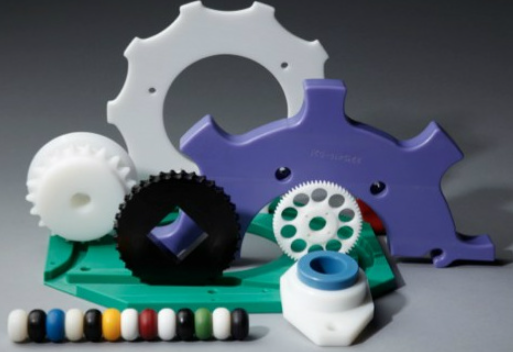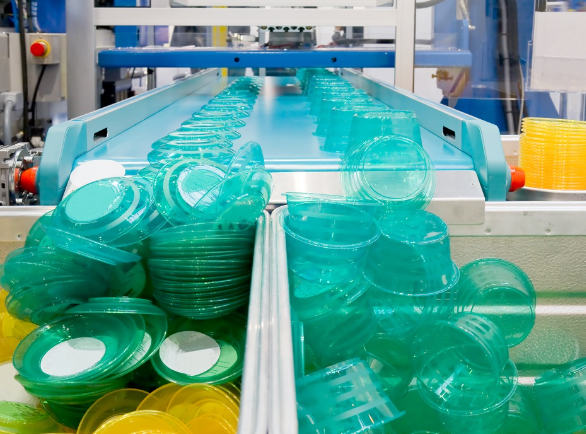The methods for fabricating plastic include injection molding, blow molding, extrusion, 3D printing, and rotational molding.
Primary Methods of Plastic Fabrication
Injection Molding
Process Description
Injection molding involves melting plastic granules and injecting them into a mold at high pressure. This method allows for high-volume production of plastic parts with excellent precision. First, we heat the plastic until it becomes fluid. The plastic cools and solidifies, forming the final product. This process is highly efficient, with a cycle time ranging typically from 15 to 30 seconds per part.

Types of Materials Used
Common materials for injection molding include Polyethylene (PE), Polypropylene (PP), Polycarbonate (PC), and Acrylonitrile Butadiene Styrene (ABS). Each material offers unique properties like durability, flexibility, and resistance to heat and chemicals.
Blow Molding
Process Description
Blow molding specializes in creating hollow plastic parts. The process begins with melting down the plastic and forming it into a parison or preform. Blow molding is ideal for manufacturing bottles, containers, and other hollow shapes.
Applications
This technique is extensively used for making water bottles, fuel tanks, and plastic drums. Its ability to create uniform, thin-walled containers makes it a preferred choice for products requiring precise weight and strength specifications.
Extrusion
Varieties of Extrusion Methods
Extrusion methods vary, including sheet extrusion, profile extrusion, and tubing extrusion.Tubing extrusion, as the name suggests, is ideal for creating plastic tubes and hoses.
Extrusion Equipment and Setups
The equipment typically includes a hopper, a screw mechanism, a heater, and a die. The plastic material is fed into the hopper, where it moves towards the die while being heated and melted. The screw mechanism pushes the molten plastic through the die, shaping it according to the desired cross-section. The speed of the screw and the temperature settings are crucial for ensuring product quality. Extrusion equipment varies in size, with larger machines producing greater output but also consuming more power, impacting operational costs.
Advanced Fabrication Techniques
3D Printing with Plastics
Types of 3D Printing Technologies
3D printing has revolutionized the way we create plastic parts. Key technologies include Fused Deposition Modeling (FDM), Stereolithography (SLA), and Selective Laser Sintering (SLS). FDM printers work by melting plastic filaments and depositing them layer by layer to build the object. They are popular for their affordability and ease of use, typically ranging in price from $200 to $4,000. SLA printers use a laser to cure liquid resin into hardened plastic. SLS technology involves lasers that sinter powdered plastic, creating strong and detailed objects suitable for industrial applications, with costs often exceeding $200,000.
Materials Compatibility
These technologies support a variety of plastics, including PLA, ABS, Nylon, and TPU. Each material offers distinct advantages.
Rotational Molding
Process Overview
As the mold rotates, it transfers heat to the material, evenly coating the interior to form the part. The rotation continues during the cooling phase to ensure a uniform thickness. This method is highly cost-effective for short-run productions, typically costing 25% less than injection molding for small batches.
Design Considerations
When designing for rotational molding, it is essential to consider factors like uniform wall thickness, which generally ranges from 3mm to 10mm, and the incorporation of ribs and kiss-offs for added strength. Avoiding sharp corners and extreme contours ensures better material flow and longevity of the mold. The typical mold cost ranges from $2,000 to $25,000, influenced by complexity and size. The process supports a wide range of sizes, from small items like balls to large tanks of 20,000 liters or more.
Material Science in Plastic Fabrication
Properties of Commonly Used Plastics
Understanding the properties of various plastics is crucial for optimal fabrication.
- Polyethylene (PE):
- Low Density (LDPE): Flexible, high resistance to impact. Used in film applications and bags.
- High Density (HDPE): Greater strength, used in containers, bottles, and piping.
- Polypropylene (PP): High fatigue resistance, used in automotive parts and textiles.
- Polycarbonate (PC): High impact strength, transparent, used in eyewear and bullet-proof glass.
- Polyvinyl Chloride (PVC): Versatile, used in pipes, medical equipment, and vinyl records.
Each type of plastic comes with a unique set of properties like tensile strength, melting point, and flexibility, impacting its suitability for different applications.
Material Selection for Different Fabrication Methods
Material choice is critical for successful fabrication, depending on the method and product requirements.
- For Injection Molding:
- ABS: Offers good thermal and dimensional stability, with a melting point around 200°C.
- Nylon: Known for its strength and temperature resistance, ideal for gears and bearings.
- For Blow Molding:
- HDPE: Known for its strength and chemical resistance, used in bottles and containers.
- PET: Offers clarity and barrier properties, commonly used in beverage bottles.
- For Extrusion:
- LDPE: Common for film and sheet applications, due to its flexibility.
- PVC: Used in pipes and profiles, offers rigidity and chemical resistance.
Quality Control and Testing in Plastic Fabrication
Standards and Protocols
In plastic fabrication, adhering to international standards and protocols ensures consistency and safety. Some of the key standards include:
- ISO 9001: Focuses on quality management systems and operational efficiency.
- ASTM International: Provides a wide range of standards for testing various plastic properties.
- ISO 14001: Addresses environmental management, crucial for sustainable practices in plastic production.
Manufacturers must comply with these standards to guarantee product reliability and meet global market requirements. Regular audits and certifications are part of maintaining these standards, ensuring ongoing quality and performance.
Testing Methods for Fabricated Plastics
Testing fabricated plastics involves various methods to assess their properties and suitability for specific applications. These methods include:
- Tensile Testing: Measures the strength and elongation of plastic materials. It is critical in determining the usability of plastics under stress.
- Impact Testing: Assesses how a material reacts to sudden forces or impacts.
- Thermal Analysis: Determines the material’s behavior under different temperature conditions. This includes tests like Differential Scanning Calorimetry (DSC) and Thermogravimetric Analysis (TGA).
- Chemical Resistance Testing: Evaluates how a plastic reacts to various chemicals, crucial for materials used in harsh environments.

Environmental Considerations in Plastic Fabrication
Recycling and Reuse of Plastic Materials
Recycling and reuse play a pivotal role in reducing the environmental footprint of plastic fabrication. Key aspects include:
Mechanical Recycling: This involves grinding, washing, and remelting plastic waste to form new products.
Chemical Recycling: Breaks down polymers into their constituent monomers, which can be repolymerized into new plastics. This method is particularly effective for mixed or contaminated plastics.
Design for Recyclability: Manufacturers are increasingly designing products with recyclability in mind, using mono-materials and avoiding non-recyclable additives.
Effective recycling and reuse strategies help in conserving resources and minimizing landfill waste. Innovations in this field are constantly evolving, aiming to increase the lifecycle of plastic materials.
Reducing Environmental Impact in Fabrication Processes
Minimizing the environmental impact during the fabrication of plastics involves several strategies:
Energy Efficiency: Modern fabrication facilities focus on reducing energy consumption.
Waste Minimization: Implementing closed-loop systems in the manufacturing process can significantly reduce waste.
Use of Bioplastics: Bioplastics, derived from renewable resources like corn starch, reduce reliance on fossil fuels and are often biodegradable, offering a more sustainable alternative to conventional plastics.




